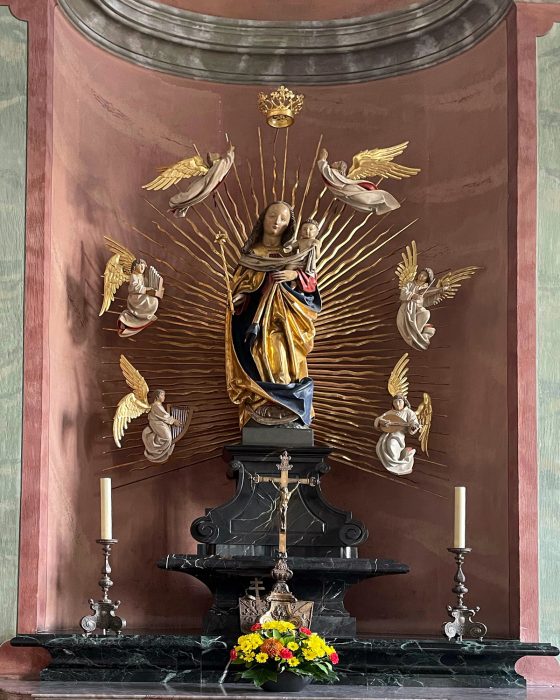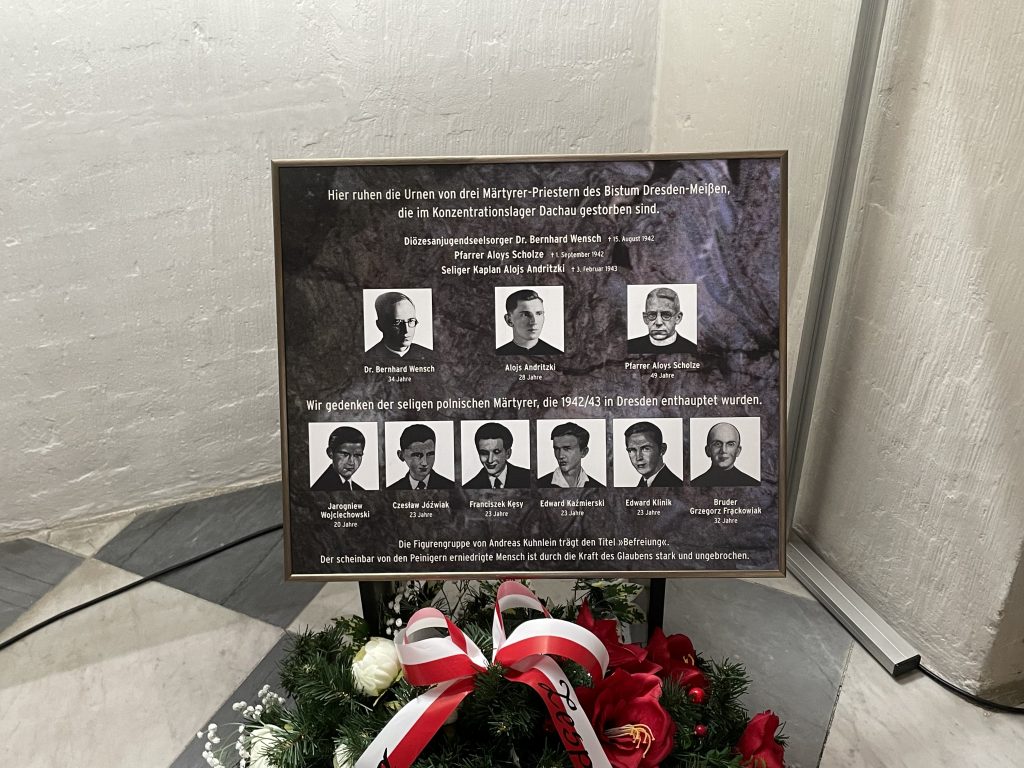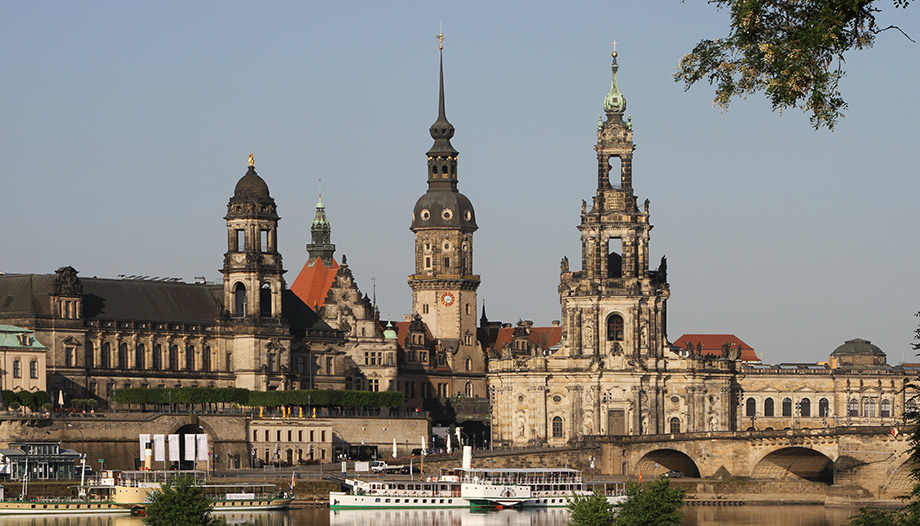Dresden, the present-day capital of the German federal state of Saxony, has been called "Florence on the Elbe" or "German Florence" since the early 19th century. This nickname is attributed to the writer and philosopher Johann Gottfried Herder, who used it in 1802 to refer to the magnificent art collections, especially Italian, that Dresden houses. Among these works is the "Sistine Madonna" by Raphael (1512/1513).
The designation "Florence on the Elbe" is also due to Dresden's architecture. Many of the characteristic buildings, especially those of the "Dresden Baroque", were built under Italian, particularly Florentine, influence. Even the early 19th century architecture in Dresden was inspired by these models.
The Protestant "Frauenkirche" ("Church of Our Lady"), built between 1726 and 1743 according to plans by George Bähr, is an emblematic example. It was the first building north of the Alps to have a large stone dome, similar to that of the cathedral in Florence.
It was completely destroyed in the bombings of the night of February 13-14, 1945; its charred ruins served, during the German Democratic Republic, as a memorial against war and destruction. However, after the GDR's extinction, it was rebuilt between 1994 and 2005, according to the original plans, with donations from all over the world.
Next to Dresden Palace, the residence of the prince electors (1547-1806) and kings (1806-1918) of Saxony, built in various styles from Romanesque to Baroque, stands Dresden Cathedral, which was originally the Court Church ("Hofkirche"), the name by which it is still known today.

Saxony was one of the first territories to adopt Luther's "Reformation": the Elector Frederick III - nicknamed Frederick the Wise, among other things because he founded the University of Wittenberg - is known to have been one of Martin Luther's main patrons, as well as the painter Dürer.
However, Augustus "the Strong" converted to Catholicism in 1697 in order to accede to the throne of Poland, which caused tensions in Protestant Saxony; therefore, he discreetly practiced the Catholic faith in the palace chapel and, at the same time, generously supported the construction of the aforementioned Protestant Frauenkirche as Dresden's main church.
The Court Church was commissioned by his son, Elector Frederick Augustus, who had also converted to Catholicism in 1712. He succeeded him in 1733 as Elector of Saxony and in 1734 by election also as King of Poland (under the name Augustus III). In 1736 the planning of the church was entrusted to the Roman Gaetano Chiaveri, who also worked for the king in Warsaw.
Dresden Cathedral
The present cathedral was built between 1739 and 1755, and was consecrated on June 29, 1751 by the apostolic nuncio to Poland, Archbishop Alberico Archinto, under the patronage of the Holy Trinity. It was elevated to the rank of co-cathedral in 1964 and became the cathedral of the Diocese of Dresden-Meissen in 1980, when the episcopal see was transferred from Bautzen to Dresden.
Thus, the largest church in Dresden - whose main nave is 52 meters long, 18 meters wide and 32 meters high, and whose tower reaches a height of 86 meters - was once a Catholic church in a city with a clear Protestant majority. Today, Christians make up barely 20 percent of the population: 15 percent Evangelical Christians and only five percent Catholics.
It is an outstanding example of Dresden Baroque. It is the only large royal building designed by a foreign architect, the aforementioned Gaetano Chiaveri, and was inspired by churches built by Francesco Borromini and the Chapel of the Palace of Versailles. The church has three naves and has a processional aisle of 3.50 meters wide that allows processions, because in the Protestant Dresden Catholic processions could not be held outdoors.
The interior of the cathedral
The simple interior contrasts with the rich exterior decoration, with 78 figures of saints 3.50 m high sculpted in sandstone (1738-46), work of Lorenzo Mattielli, on the balustrade that surrounds the entire nave.
In the interior, contrasting with the white of the walls, the main altar in marble with gilded bronze decorations, the work of the Aglio brothers, depicting the Ascension, 10 meters high and 4.50 meters wide, the work of the Dresden court painter Anton Raphael Mengs, stands out. The painting, begun in Rome in 1752 and completed in Madrid in 1761, arrived in Dresden in 1765.
Like the Frauenkirche, the Court Church was also severely damaged during the air raids in February 1945; the roofs and vaults collapsed and the outer walls were partly completely destroyed.
The reconstruction was completed in 1965. After more than 50 years, extensive restoration works were carried out from March 2020 to February 2021.
Today, the right aisle is dedicated to the Virgin Mary, with an altar featuring a figure of the Virgin with a crown of angels, a copy of the central part of the Mühlhausen altar of the cathedral of Bamberg (made by Hermann Leitherer in 1987). On the back wall of the chapel is a sculpture of St. Mary Magdalene (Magdalene Penitent) by Francesco Baratta.
The chapels of the apse include the Blessed Sacrament - with an altarpiece on the institution of the Eucharist: the original, made in 1752 by Louis de Silvestre, was lost in 1945 and was replaced in 1984 by a recreation by the painter Gerhard Keil - and that of St. Benno, in the southeast chapel, presided over by an altarpiece by Stefano Torelli, also from 1752, representing Bishop Benno preaching the Christian faith to the Sorbos, a Slavic minority in the diocese of Dresden-Meissen. A miter of the holy bishop is preserved in a reliquary on the altar, made in 1997 by Paul Brandenburg.
The altar of the martyrs
Finally, in the left aisle is the altar of the martyrs, which houses the urns of the three martyrs Alois Andritzki, Bernhard Wensch and Aloys Scholze. Their ashes were moved in procession from the Old Catholic Cemetery on February 5, 2011. Alois Andritzki was beatified in a pontifical mass celebrated in front of the cathedral on June 13 of the same year.
On a table with the photos of the three martyrs it is written: "Here rest the urns of three martyr priests of the Diocese of Dresden-Meissen who died in the concentration camp of Dachau". Below them are reproduced the photographs of "the blessed Polish martyrs beheaded in Dresden in 1942/43".









